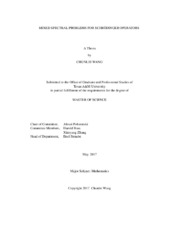| dc.description.abstract | In this thesis, we discuss the mixed spectral problem for Schrödinger operators and study the invertibility properties of a certain Toeplitz operator. Further results of mixed spectral problems obtained by Borg, Hochstadt, Liberman and Horvath are mentioned.
In the first section, we summarize some basic facts of meromorphic inner functions, Herglotz functions, de Branges functions, and model spaces. We define the spectrum of a meromorphic inner function Θ by {Θ = 1}. From the construction of a Weyl inner function of a Schrödinger operator, we show that the Dirichlet boundary condition can be replaced by any other boundary conditions with a trivial transform. Also, we discuss a chain structure of the de Branges spaces associated with de Branges functions E which are obtained from the solutions of a Schrödinger equation.
In the second section, we define the kernel of a Toeplitz operator and discuss the criterion of the triviality of the kernel. If we consider regular Schrödinger operators, after proving the ratio of the two meromorphic inner functions of different Schrödinger equations is a trivial factor, we can replace any non-trivial regular potentials by a trivial potential.
In the last section, we study the spectral problems for the Schrödinger operators. Firstly, we discuss the completeness problem of the model space in terms of the invertibility properties of a Toeplitz operator. Then we apply the Toeplitz kernels to the spectral problems. Especially, we characterize the mixed data spectral problem by a determination proposition of meromorphic inner functions Θ = ɸψ. Combined with our definition of the spectrum of a meromorphic inner function, we recover a meromorphic inner function ɸ from the spectrum of Θ and the known factor ɸ: Furthermore, we use this characterization to prove Hochstadt-Liberman’s theorem and Horvath’s theorem. | en |


